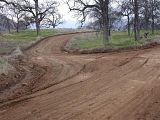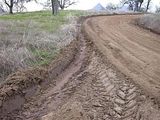About "Using the box blade in reverse for gravel / snow"
I don't know about snow because I don't have any here in So. Cal. but the concept should be universal.
Using the boxblade in reverse is a wonderful technique. It is very hard when using the fel or pulling the box blade to cut a level surface when your tractor drives over humps and gullies or on a slope. The fel or box blade tends to "follow" those contours and slope. Even adjusting the "tilt" on the box blade to cut out a slope, it will still rise and fall over the humps. The advantages are that when you push in reverse, your tires are now on the part that is cut and level....no more rise and fall.
I find that my box blade cuts really good in reverse so I use it like a dozer blade to level an area. Sometimes I don't want to use the scarifiers when leveling an area. Seems like on some hard surfaces, pulling doesn't penetrate but the cutting blade just rides over the hard spot. Not so in reverse...the blade digs in and really cuts good. After you've gotten rid of all the humps you can then drag the box blade and it will produce a really nice smooth surface, and follow the slope you made because you've prepped it properly.
Here is a picture of some road smoothing done with the box blade.

Another thing about dozing in reverse is that you push the pile of dirt clear off the area, instead of leaving the pile in the road. So when I wanted to cut a slope for a drainage gutter, I pushed the dirt clean out of the way with the desired slope/tilt. I'd have to stop the tractor before falling off a drop off if I did it pulling.

Be sure to determine your lower drag links are sturdy enough to take the pressure. I have read many posts where those arms bent. So with that in mind, I'd seriously consider strengthening them so I could use that method frequently. My tractor is pretty heavy duty with thick lower arms, but I may still weld a gusset reinforcing along the length for that very purpose.
Hope that helps.

